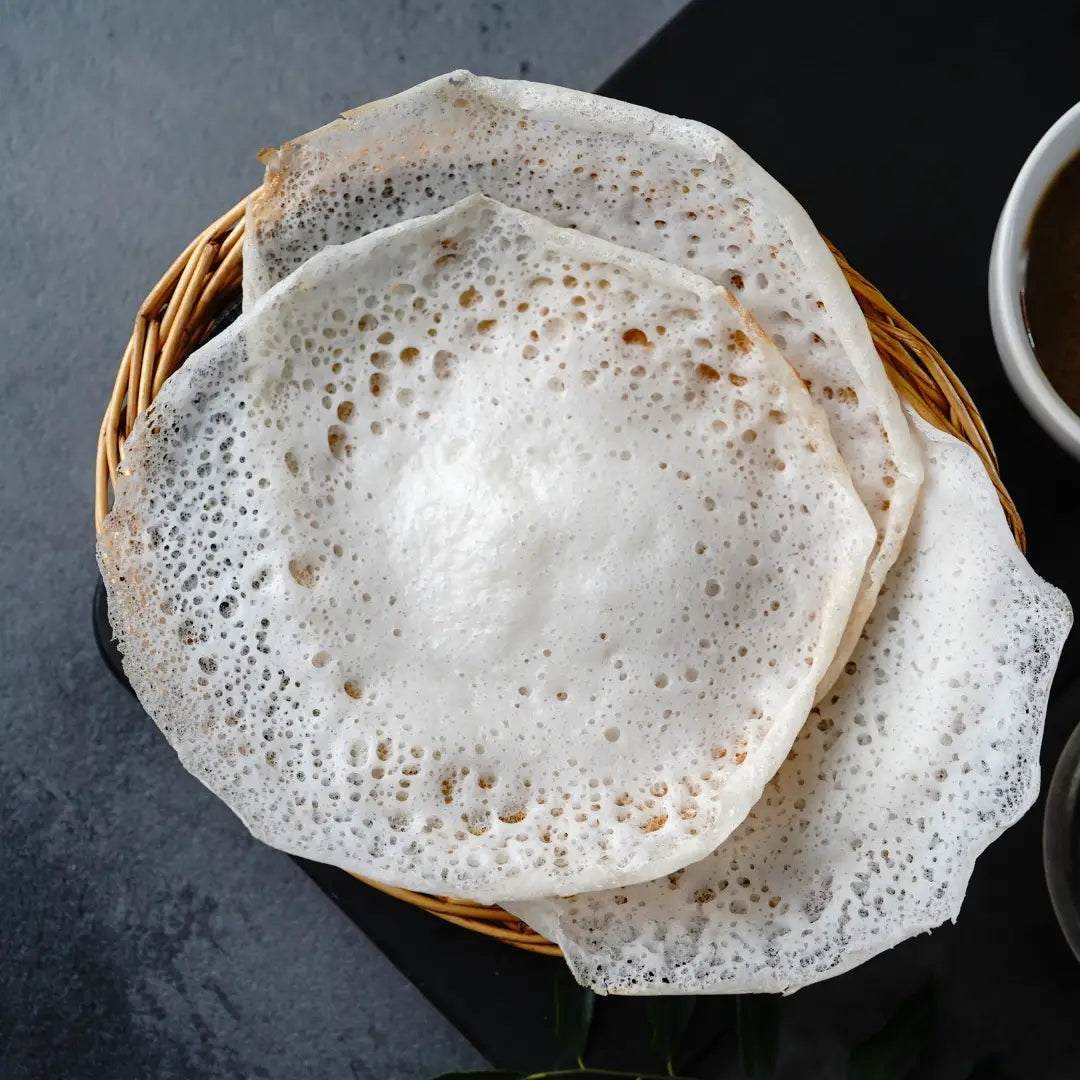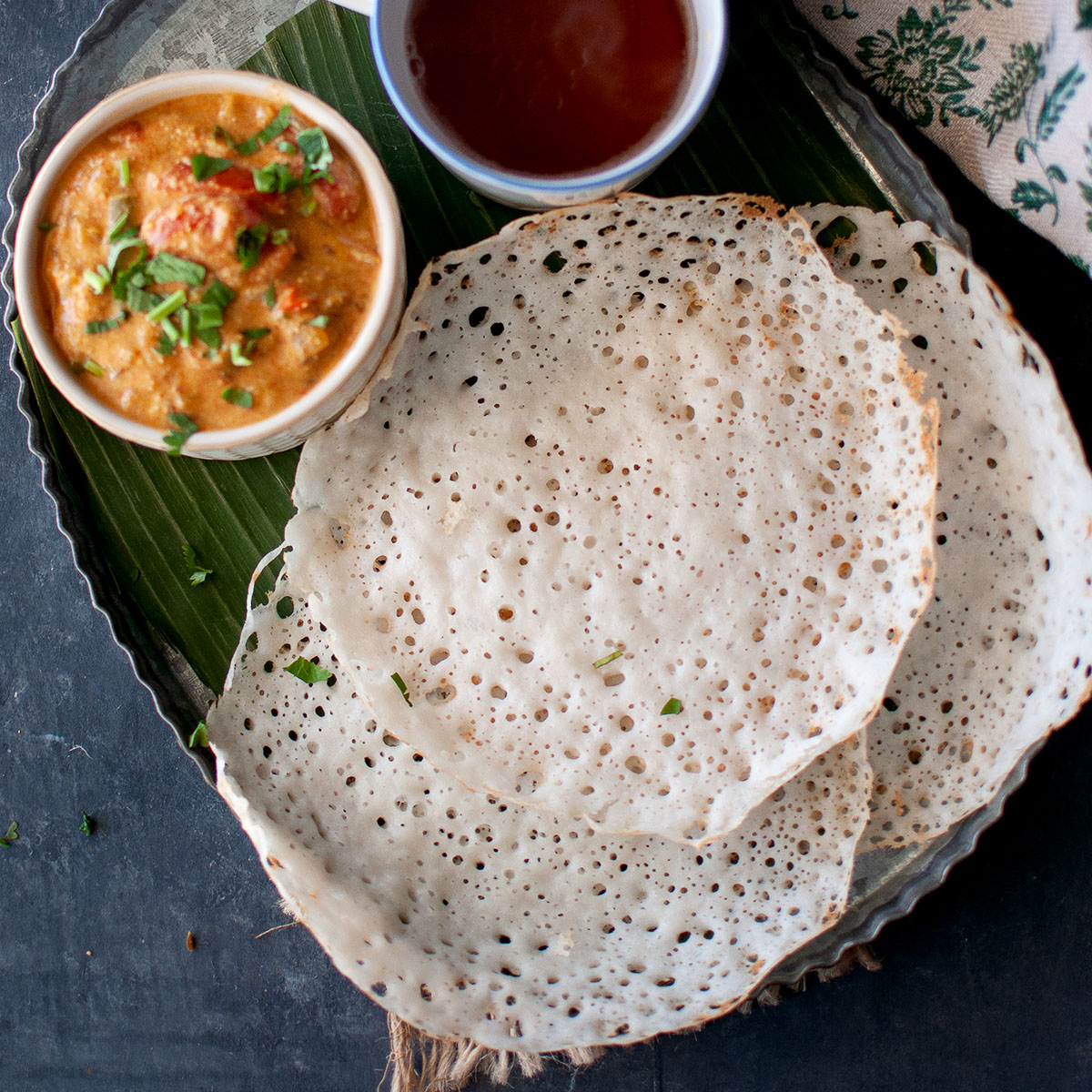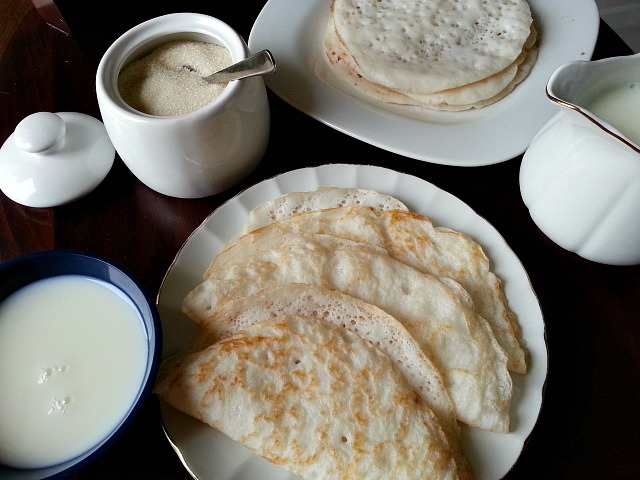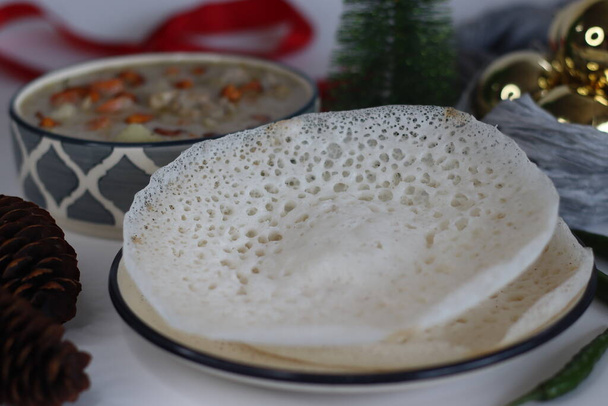Appam, a beloved staple from the Southern Indian culinary repertoire, is more than just food; it is a tender whisper of tradition spun into a delicate, lacy crepe. It woos the senses with its soft, fluffy center and paper-thin, crispy edges—a textural ballet that dances on the palate. As you venture into the ethereal world of Appam, imagine a breakfast where each bite is a cloud sourced from the kitchens of gods, its very essence promising to transport you to the tranquil backwaters and lush landscapes of Kerala.
This delightful pancake is a canvas of ground rice and coconut milk, subtly fermented to achieve its characteristic tang. The fermentation not only adds complexity to the flavor but also endows Appam with a feathery lightness unmatched by any other. Traditionally twirled in a small wok to create its mesmerizing shape, the Appam gently rises as it cooks, forming a pillowy base enveloped by a crisp lace, embodying the dichotomy of robust heritage and ephemeral delicacy.
Appam Soft Rice Pancakes Recipe


Appam Soft Rice Pancakes
Equipment
- 1 large bowl
- 1 blender
Ingredients
- 1 cup raw rice sona masoori or ponni variety, rinsed at least twice under cool water, drained well
- 1 cup cooked rice preferably a day old, at room temperature
- 1/2 cup shredded fresh coconut or frozen, thawed to room temperature
- 1 teaspoon sugar
- 1 teaspoon salt
- 11/2 cups water divided
Instructions
- In a large bowl, combine the raw rice and enough cold water to cover by 2 to 3 inches. Let soak at room temperature for 6 to 8 hours. Drain.
- In a blender, combine the drained raw rice, cooked rice, coconut, sugar, and salt. Pulse the blender a few times to grind. With the blender running, slowly add 1 cup of water until it forms a smooth, runny batter. Transfer the batter to a large bowl. Rinse the blender with the remaining 1⁄2 cup of water and pour this into the bowl with the batter. Stir well.
- Cover the bowl with a lid or plastic wrap and place it in a warm place to ferment for 8 to 10 hours. Stir the batter before cooking it.
- Heat the appam pan over medium heat.
- Reduce the heat to low and add one ladleful of batter. Rotate the pan to spread the batter and form a bowl shape. Increase the heat to medium, cover the pan, and cook for 11⁄2 to 2 minutes. Once cooked, the edges will separate from the pan. Using a spatula, remove the appam from the pan. Repeat with the remaining batter.
Notes
Cooking Tips about Appam Soft Rice Pancakes

- Batter Consistency: The batter for Appam is crucial; it should be of pourable consistency but slightly thicker than milk. This ensures that when poured into the pan, it can spread into a thin layer and yet hold enough substance to form the spongy center.
- Fermentation: Fermentation is key to get the right taste and texture in Appams. The batter usually consists of soaked and ground rice mixed with coconut milk and allowed to ferment overnight.
- Cooking Pan: Traditionally, an Appam is cooked in an Appam Chatti, which is a small wok with a lid. The shape of the pan helps create the pancake’s unique bowl-like shape with thicker centers and paper-thin edges.
- Swirling Technique: Once the batter is poured onto the heated pan, it’s quickly swirled around to spread the mixture. Then it’s covered and cooked solely on one side, allowing the edges to become crisp and the center to puff up and stay fluffy.
- Temperature Control: Manage the heat so that the edges brown without becoming too brittle or burning. The center must cook through with just the steam, maintaining its softness.
- Greasing the Pan: To avoid sticking and to achieve a golden hue on the edges, the pan should be greased lightly with oil or ghee before pouring the batter.
- Resting the Batter: After adding water and before cooking the Appams, let the batter rest for some time. This could allow the ingredients to combine well and result in better-textured pancakes.
- Serving Tip: They are best served hot and fresh out of the pan alongside accompaniments like a stew or coconut milk.
Serving suggestions about Appam Soft Rice Pancakes

- Savory Options:
- Curries: Appam is commonly served with a variety of curries. Rich, coconut milk-based curries with chicken, beef, fish, or vegetables work particularly well. The slightly sweet flavor of the appam balances the spices in the curry.
- Stew: A traditional Kerala-style stew made with coconut milk, potatoes, carrots, and meat like chicken or lamb is another popular pairing.
- Egg Roast: A spicy preparation of hard-boiled eggs in a tomato and onion gravy can be a delightful combination with the soft rice pancakes.
- Sweet Options:
- Coconut Milk and Sugar: For a simple but delicious treat, appam can be soaked in sweetened coconut milk.
- Jaggery Syrup: Drizzling jaggery syrup, made from concentrated date, palm, or cane juice, can provide a sweet and molasses-like flavor.
- Fusion and Innovative Pairings:
- Spicy Tuna or Chicken Salad: For a twist, top appam with a mixture of flaked tuna or chicken with diced onions, tomatoes, and green chilies dressed with lime juice and spices.
- Ice Cream and Tropical Fruits: Serve appam with a scoop of ice cream and tropical fruits like mango or banana for a dessert variation.
Top 5 FAQs about Appam Soft Rice Pancakes

- What are the ingredients used in making Appam? The primary ingredients for Appam are raw rice or parboiled rice, coconut milk, sugar, and yeast. Some recipes may also include cooked rice or poha (flattened rice) to adjust the texture, a bit of salt, and sometimes an egg to enrich the batter.
- How is Appam batter made? To prepare the batter, rice is soaked in water for a few hours and then ground to a fine consistency. Cooked rice or poha may be added, along with coconut milk, yeast, sugar, and a pinch of salt. This mixture is then left to ferment. Fermentation time can vary but typically ranges from 8 hours to overnight, depending on the ambient temperature. After fermentation, the batter should have slightly expanded and developed a mildly sour aroma.
- What is the best way to cook Appam? Appams are traditionally cooked in an Appam pan, which is similar to a small wok with steep sides, giving them their distinctive bowl shape. The pan is lightly greased, then batter is poured in and swirled around to evenly coat the sides while the thicker portion settles at the bottom. The Appam is covered and cooked over medium heat, allowing the edges to become crisp and the center to puff up and remain soft. No flipping is usually required.
- Can Appam batter be stored? Yes, the Appam batter can be refrigerated for use over several days, although it’s best used within 2-3 days. The sourness will increase with time, which might be desirable for some but not for others. Before storing, ensure the batter is kept in an airtight container to prevent contamination or absorption of other flavors from the refrigerator.
- Are there any variations in Appam recipes? Variations in Appam recipes abound across regions. Some might sweeten the batter more and serve them with stews or curries, while others might incorporate different types of rice or use toddy in place of yeast for fermentation. There are also versions such as “Egg Appam,” where an egg is cracked into the pancake as it cooks, and “Palappam,” which contains more coconut milk for a richer flavor.
Appam is a type of pancake, originating from the Kerala region in the south of India, made with fermented rice batter and coconut milk. The fermentation process is key to Appam’s unique texture and flavor. This pancake is distinctive for its thin, crisp edges with a fluffy, soft center resembling a dome structure. Traditionally, it is eaten with a variety of side dishes such as vegetable stew, chicken curry, or coconut chutney.

Leave a Reply